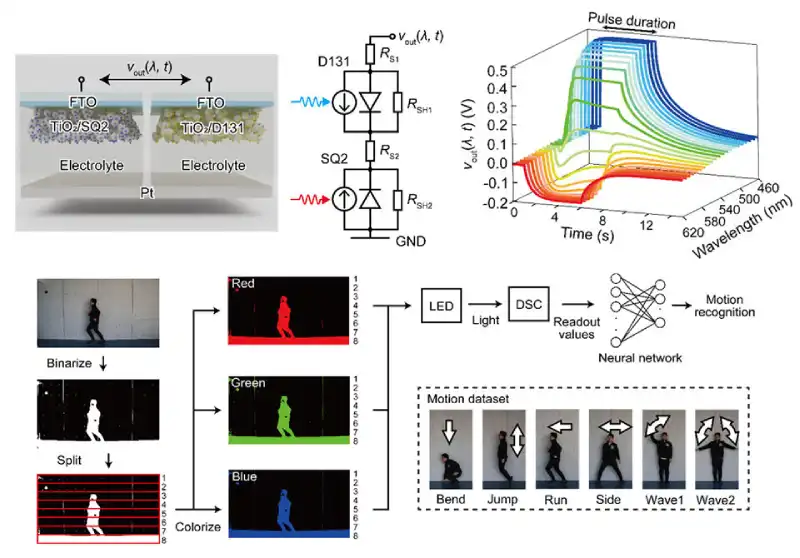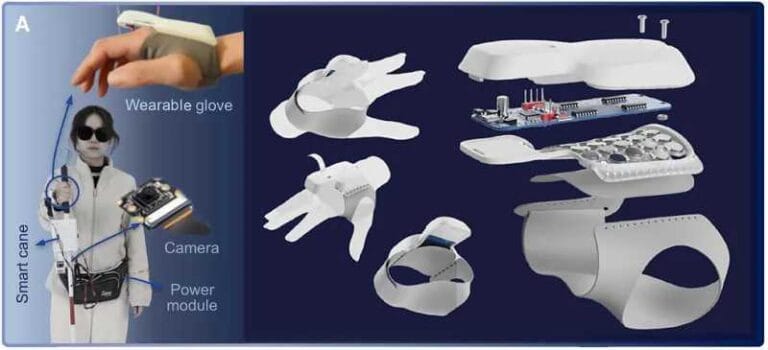New artificial synapse recognizes colors like the human eye

Researchers from the University of Tokyo have developed a self-powered optoelectronic artificial synapse that can recognize colors with a precision of 10 nanometers and perform typical artificial intelligence tasks, such as classification and logic operations, with extreme energy efficiency.
“This study presents a self-powered, polarity-adjustable optoelectronic artificial synapse integrating dye-sensitized solar cells,” the authors state in the paper.
The innovation lies in the combination of two dyes — D131 and SQ2 — applied to solar cells, which generate electrical signals with distinct polarities depending on the color of incoming light. This property was harnessed to create a light-based neuromorphic computing system.
The device’s operation is inspired by the way the human eyes and brain process visual information. In the human body, light signals are converted into electrical impulses and filtered by synapses before reaching the brain, optimizing energy use.
“Inspired by this mechanism, optoelectronic artificial synapses that mimic synaptic behavior have gained attention as key components for next-generation, energy-efficient machine vision systems,” the paper explains.
The developed device replicates this behavior by responding to light pulses with voltage changes — either positive or negative — that vary according to the wavelength of the incoming light.
According to the authors, the system responds with different electrical signals to wavelengths ranging from 450 to 750 nm, with a resolution of 10 nm. The response can be positive or negative depending on the color — for example, blue produces a positive voltage, while red generates a negative one.
“The wavelength-dependent bipolar response enables exceptional separation capabilities, achieving six-bit resolution with 64 distinct states and supporting multiple logic operations, including AND, OR, and XOR, within a single device.”
This marks a significant advancement over previous artificial synapses, which operated unipolarly or relied on constant light intensity to differentiate colors.
The artificial synapse was also used as the core of a physical reservoir computing (PRC) system, a machine learning approach that efficiently processes temporal data.
“The concept of PRC is to reduce training costs by transforming temporal data through a material and training only a lightweight output layer, such as a linear regression model.”
In this experiment, the input data consisted of light pulses encoded in red, green, or blue. The device’s response was then used as input for a simple single-layer neural network with a softmax activation function.
To evaluate its practical applicability, the researchers assigned the device a colored motion recognition task. Using LEDs in red (650 nm), green (570 nm), and blue (450 nm), six types of human actions were presented: jumping, running, side-stepping, bending, waving with one hand, and waving with both hands.
“The multicolored motion recognition task was performed based on the device’s readout values, with a fixed readout time of 10 ms.”
The device was able to distinguish the colors with 100% accuracy and correctly classified the movements with an overall accuracy of 82%. According to the authors, the main advantage was the ability to generate distinct responses for the three primary colors using just a single component.
In addition to pattern classification, the system was also capable of performing classic logic operations. AND, OR, and XOR functions were implemented using only variations in light color and intensity.
“We demonstrated the AND, OR, and XOR logic operations using red and blue light as inputs.”
The XOR operation — typically difficult to implement with optical sensors — was made possible by the alternating polarity of the device’s electrical response.
According to the authors, the device shows promise for low-power optical systems, such as sensors embedded in autonomous vehicles, wearable devices, or biomedical equipment. However, some aspects still need improvement, such as better defining thresholds between logic levels “0” and “1.”
“We believe that the successful implementation of AND, OR, and XOR logic functions is significant as a proof of concept.”
They suggest that, in the future, the device’s output could be connected to low-voltage rectifying circuits, such as Schottky diodes, to improve the robustness of the logic system.
Reference: KOMATSU, Hiroaki; HOSODA, Norika; IKUNO, Takashi. Polarity-tunable dye-sensitized optoelectronic artificial synapses for physical reservoir computing-based machine vision. Scientific Reports, vol. 15, no. 16488, 2025. DOI: 10.1038/s41598-025-00693-0.






